
Energy-based Aesthetic Devices Market Size, Share & Trends Analysis Report, By Product (Medical Laser-Based Devices, Light-Based Devices), By Application, By End Use, By Region, And Segment Forecasts, 2024 - 2030
- Report ID: GVR-4-68039-970-2
- Number of Report Pages: 110
- Format: PDF, Horizon Databook
- Historical Range: 2018 - 2023
- Forecast Period: 2024 - 2030
- Industry: Healthcare
Market Size & Trends
The global energy-based aesthetic devices market size was estimated at USD 6.36 billion in 2023 and is projected to grow at a CAGR of 14.2% over the forecast period. Rising awareness regarding medical aesthetics is one of the factors boosting market growth. The demand for cosmetic procedures among diverse patient populations is increasing.
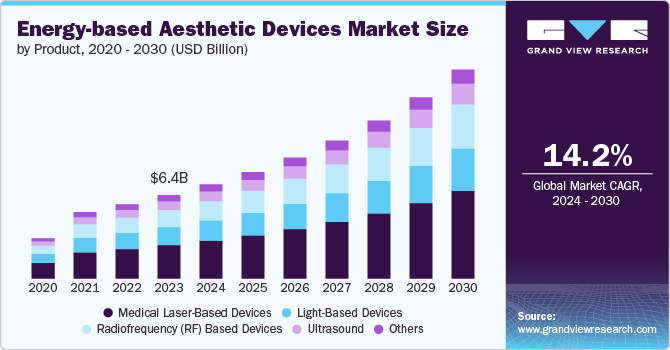
Energy-based Aesthetic Devices Market Size, by Product, 2020-2030, (USD Billion)
According to an article published in the Journal of Clinical and Aesthetic Dermatology in July 2024, African American and Asian patients accounted for 28% of cosmetic procedures in the U.S. This growth is fueled by advancements in energy-based devices, including microfocused ultrasound and fractional radiofrequency (RF), which are effective across all skin tones. These technologies have revolutionized non-invasive treatments for skin laxity, acne scars, pigmentation disorders, and wrinkles.
Advancements in energy-based aesthetic devices are driving the market growth. According to The Aesthetic Guide article published in October 2023, Micro-Coring is an innovative technique gaining popularity for enhancing skin texture and tightening areas prone to laxity, such as the lower face & jowls. This non-invasive method removes tiny tissue cores to stimulate skin rejuvenation and tightening. The significance of Micro-Coring lies in its ability to offer substantial improvements in skin quality with minimal downtime, making it an appealing option for patients seeking effective aesthetic treatments without resorting to invasive surgery.
The rising prevalence of obesity is driving the demand for effective treatment options, including energy-based aesthetic devices. As more individuals seek solutions to manage and reduce obesity-related concerns, the market for noninvasive treatments is expanding. Energy-based aesthetic devices offer innovative body contouring and weight management approaches, positioning them as crucial in addressing the growing global obesity epidemic. According to a WHO article published in March 2024, obesity has become a significant global health concern, with 1 in 8 people worldwide affected by this condition in 2022. The rate of adult obesity has more than doubled since 1990, while adolescent obesity has increased fourfold. In particular, 2.5 billion adults are now categorized as overweight, with 890 million living with obesity. In addition, 43% of adults aged 18 & over were overweight, and 16% were affected by obesity. Among children, 37 million under the age of 5 and over 390 million aged 5-19 were overweight, with 160 million of the latter group being obese.
Number of Plastic Surgeons in 2022
|
Sr. No |
Country |
Number of Plastic Surgeons |
|
1 |
U.S. |
7,461 |
|
2 |
Brazil |
6,200 |
|
3 |
Mexico |
2,394 |
|
4 |
Japan |
3,050 |
|
5 |
China |
3,000 |
|
6 |
India |
2,600 |
|
7 |
Germany |
1,550 |
|
8 |
Italy |
1,151 |
|
9 |
France |
1,000 |
|
10 |
UK |
600 |
Source- International Society of Aesthetic Plastic Surgery (ISAPS) article 2022
Recent data has highlighted a growing preference for noninvasive aesthetic procedures, highlighting a significant increase in nonsurgical treatments. According to an International Society of Aesthetic Plastic Surgery (ISAPS) article published in 2023, the total number of nonsurgical procedures reached 19,182,141, marking a 1.7% rise compared to 2022 and a 40.9% increase from 2019. This growth highlights the robust demand for noninvasive treatments driven by technological advancements and an expanding consumer base seeking effective cosmetic solutions without surgery. Detailed analysis reveals varying trends in specific procedures. Hair removal, for instance, saw a 54.2% increase from 2019 to 2023, indicating its continued popularity and efficacy.
Market Concentration & Characteristics
The market is witnessing a high degree of innovation, with companies introducing devices to integrate multiple energy modalities in a single device, AI-driven treatment customization, improved cooling systems for enhanced patient comfort, and devices with greater precision that allow targeted treatments with minimal side effects.
Several market players, such as InMode, Solta Medical, and El.en (Deka, Quanta, Asclepios ) and Sinclair, are involved in merger and acquisition activities. Through M&A activity, these companies employ key strategies such as product innovation, strategic collaborations, and geographical expansion to enhance their presence and address the growing demand for minimally invasive cardiovascular interventions. For instance, In February 2022, Viora, a global medical aesthetics market player, was acquired by Sinclair Pharma, a global aesthetics company based in London and a wholly owned subsidiary of Huadong Medicine Company Limited.
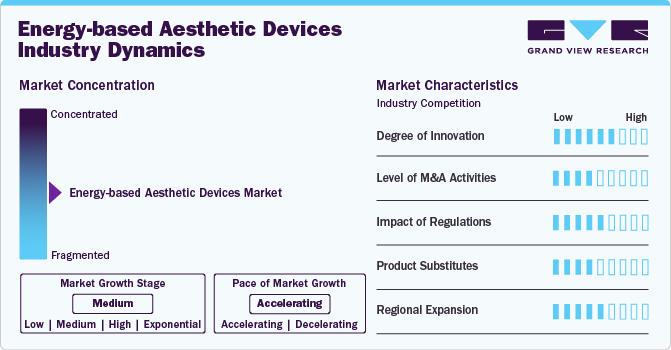
Regulations in the energy-based aesthetic devices industry ensure safety and efficacy. However, they can also slow down innovation and increase the time and cost of bringing new devices to market. Compliance with stringent standards is essential for market entry, impacting the pace at which new technologies are adopted.
There are currently no direct substitutes. Potential substitutes include topical treatments such as creams and serums that target wrinkles, fat, or skin texture. These alternatives offer different levels of effectiveness, cost, and invasiveness.
Market players in the energy-based aesthetic devices sector are expanding their presence by entering new geographical markets, forming strategic partnerships with local distributors, and tailoring their product offerings to align with specific regional healthcare requirements. For instance, in March 2022, Cynosure announced that its subsidiary, Cynosure KK, has established a distribution partnership with Jeisys Medical KK, a division of Jeisys Medical Inc., in Japan. Jeisys Medical is anticipated to have exclusive distribution rights for major products in Cynosure's energy-based laser range within Japan.
Product Insights
The medical laser-based devices segment held the largest share of over 39.95% in 2023 due to ongoing product advancements, growing initiatives by key companies, product launches, and increasing product adoption. Medical laser-based devices are specialized instruments that utilize focused light beams to perform precise surgical products, treat tissues, or remove unwanted materials. These devices leverage the unique properties of laser light, such as coherence & monochromaticity, for accuracy and minimal damage to surrounding tissues. Rapid advancements in laser technology have led to more effective and safer devices. Innovations such as fractional lasers, which target only a fraction of the skin at a time, allow for improved healing times and reduced adverse effects. In August 2023, Acclaro Medical introduced UltraClear Laser-Coring, a pioneering laser technology for tissue coring. This innovative device targets deep wrinkles, scars, and other age-related skin issues across all skin types while ensuring minimal discomfort and downtime. The latest mode of UltraClear enhances collagen remodeling by integrating fractional tissue coring with laser rejuvenation, eliminating the need for scalpels or sutures, and can be completed in around 30 minutes.
The light-based devices segment is expected to show lucrative growth during the forecast period. This growth is attributed to the rapid increase in the elderly population, technological advancements, product launches, and increasing demand for noninvasive aesthetic treatments. Light-based devices utilize light energy for various applications, including medical treatments and cosmetic products. Two prominent types of these devices are Dynamic Pulse Control (DPC) systems and Intense Pulsed Light (IPL) systems, which harness specific wavelengths of light to target skin conditions effectively. DPC is a sophisticated technology that modulates the pulse duration and intensity of light to optimize treatment outcomes while minimizing discomfort and adverse effects. In January 2022, Sharp Light introduced the cutting-edge Omnimax S3, a noninvasive skin and hair care device. This three-in-one machine integrates Verma Derm, radiofrequency, and DPC technologies. It is the newest device globally to amalgamate these technologies in a single system, offering an effective treatment option for the face, scalp, and hair.
Application Insights
The body contouring segment held the largest share of over 20.31% in 2023 due to increasing obesity rates across the globe, growing initiatives by key players, and recent advancements. Muscle hypertrophy and toning are induced by Magnetic Muscle Stimulation (MMS) and Electrical Muscle Stimulation (EMS), which complete the range of body sculpting operations. Acoustic Wave Treatment (AWT) uses ultrasonic waves to break down fibrous tissue and treat cellulite. Another technique for destroying targeted fat cells is laser therapy. In August 2023, the Aesthetic Society Journal published a study involving 243,886 patients, primarily women between 50 and 59 years old, who had surgeries mainly performed in the southern U.S. The study found an average of 25,352 products annually focused mainly on breast surgeries. Common preoperative comorbidities included hypertension, obesity, and diabetes; meanwhile, postoperative complications observed within 90 days were wound dehiscence, hematoma, and urinary tract infections.
The skin rejuvenation segment is expected to show lucrative growth during the forecast period. The rising awareness regarding medical aesthetics, rising obesity cases, and technological advancements are fueling the segment growth. The demand for skin rejuvenation treatments can be attributed to growing concerns about physical looks and key players' increasing advancements in skin care products, research, and development strategies. In September 2023, Cutera, Inc. launched Secret DUO, a skin resurfacing platform that employs dual nonablative fractional technologies. This system features a radio frequency microneedling handpiece and a 1540 nm erbium glass laser, allowing practitioners to customize treatments for various aesthetic concerns, including fine lines, skin texture, pigmentation, stretch marks, and scars. Each modality can be used separately or together to enhance treatment outcomes.
End-use Insights
The Medspa segment held the largest share of 31.88% in 2023. MedSpas in aesthetic clinics are facilities where cosmetic treatments are provided under the supervision of a licensed physician. These MedSpas blend aesthetic medical centers & day spas, offering rejuvenation and corrective treatments using energy-based aesthetic devices. The market growth reflects the increasing awareness and acceptance of aesthetic therapies, evident through the expanding presence of cosmetic clinics and providers. According to the American Medical Spa Association (AmSpa) article published in January 2023, the medical spa industry continued to grow during the pandemic. In 2021, 17% of the 7,430 medical spas were newly established. This reflects a dynamic and expanding industry with many new participants fueling its growth. It offers convenient access to a range of skin treatments & services and boosts the demand by providing innovative procedures and personalized solutions catering to client needs.
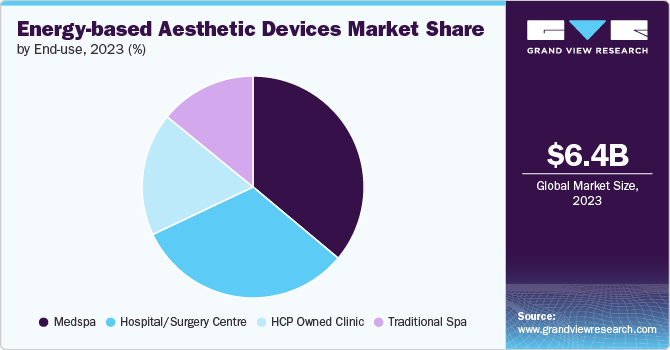
The hospital/surgery center segment is expected to show lucrative growth during the forecast period. This growth can be attributed to several factors, including the increasing demand for noninvasive aesthetic treatments, rising medical aesthetics awareness, and expanding healthcare infrastructure. Most invasive or minimally invasive cosmetic products are performed in hospitals with specialized medical and nursing staff and advanced energy-based devices. The 2022 ISAPS survey reveals that the U.S. leads globally with around 7,431 plastic surgeons, reflecting a 6% increase since 2018. Most of these practitioners are based in hospitals and clinics. In the U.S., the American Board of Plastic Surgery-certified surgeons must maintain a formal relationship with a hospital to conduct operations. In addition, the American Association for Accreditation of Ambulatory Surgery Facilities accredits nonhospital facilities, such as private plastic surgery centers, only when the practicing surgeon has hospital credentials to perform such products.
Regional Insights
The North America energy-based aesthetic devices market dominated globally with a revenue share of 39.85% in 2023, owing to the high consumer awareness, growing preference for non-invasive procedures, product launches, regulatory approvals, and advanced healthcare infrastructure that drives the demand for energy-based aesthetic devices in North America. The region’s substantial population aged between 25 and 65 years is particularly prone to skin aging concerns, such as skin laxity, wrinkles, and dark spots. In the U.S., 62% of consumers are seeking changes in their appearance. The number of aesthetic procedures performed has substantially increased over the past few years, nearly doubling to 7.45 million in 2022 compared to 2018. This demographic has contributed to a surge in demand for cosmetic enhancement products and procedures.

U.S. Energy-Based Aesthetic Devices Market Trends
The U.S. energy-based aesthetic devices market accounted for the largest share in the North America region in 2023. The critical factor for the market's growth is the rising preference for nonsurgical methods. According to a September 2023 article by the American Society of Plastic Surgeons (ASPS), there was a 19% increase in cosmetic surgeries and procedures in the U.S. from 2019 to 2022, reaching 26.2 million. This trend indicates a growing acceptance of and demand for aesthetic enhancements. The article also highlighted that nearly 23.7 million minimally invasive cosmetic procedures were performed in 2022. With 4,883,419 procedures performed, this represents a substantial 70% increase from 2019.
Europe Energy-Based Aesthetic Devices Market Trends
The energy-based aesthetic devices market in Europe held the second-largest revenue market share in 2023. This market is experiencing robust growth, driven by rising demand for minimally invasive and noninvasive cosmetic procedures. Increasing awareness of physical appearance, bolstered by the growing influence of social media, is significantly contributing to this market expansion.
Germany's energy-based aesthetic devices market is dominated by the largest revenue share, 24.72%, in 2023. The factors contributing to this large share are the presence of key market players, the rising number of noninvasive aesthetic treatments, and technological advancements. Key players are focused on developing advanced devices with enhanced precision, safety, and effectiveness. For instance, in February 2024, Braun launched the skin i·expert IPL system, which delivers a personalized hair removal experience using adaptive technology. Such advancements and the rising demand for noninvasive cosmetic procedures position Germany as a crucial hub in the global energy-based aesthetic devices industry.
Energy-based aesthetic devices market in UK held the second-largest market share in the Europe region in 2023. This large share is attributed to raising awareness regarding medical aesthetics and increasing cosmetic procedures. According to the British Association of Aesthetic Plastic Surgeons (BAAPS), the number of procedures in the UK surged to 31,057 in 2022, a 102% increase from the 15,405 procedures recorded in 2021. This significant rise follows a period when private cosmetic procedures were restricted during some coronavirus lockdowns. In 2019, before the pandemic, BAAPS reported 28,347 surgeries.
The France energy-based aesthetic devices market is anticipated to witness a significant CAGR of 14.5% during the forecast period. Growing consumer awareness about the benefits of aesthetic procedures and the increasing adoption of minimally invasive treatments drive market growth. In addition, factors such as rising purchasing power, greater participation of international players, increased spending on cosmetics and personal care, and the expanding number of beauty clinics are contributing to market growth. According to the ISAPS 2023 report, approximately 423,085 nonsurgical aesthetic treatments were performed in France, including 60,000 hair removal procedures.
Asia Pacific Energy-Based Aesthetic Devices Market Trends
The Asia Pacific energy-based aesthetic devices market is expected to grow at the fastest CAGR during the forecast period. Growing research and development (R&D) investments, increasing demand for noninvasive aesthetic treatments, rising geriatric population, and technological advancements are significant market expansion drivers. According to the ISAPS 2022 report, about 2,100,169 nonsurgical procedures were performed in Japan, with hair removal procedures being the most common. Hair removal procedures accounted for 595,232, making up approximately 28.3%. This significant volume of nonsurgical procedures highlights the growing demand for energy-based aesthetic devices in the region. Moreover, the increasing elderly population in the Asia Pacific region contributes to market growth. According to the United Nations Economic and Social Commission for Asia and the Pacific, in 2023, approximately 697 million individuals aged 60 years or older live in Asia and the Pacific region, constituting approximately 60% of the global older population.
India energy-based aesthetic devices market accounted for the second largest share in the Asia Pacific region in 2023 due to the surge in laser clinics across India, driving substantial growth in the energy-based aesthetic devices market. For instance, in March 2024, the 4th UNCOVER Laser, Skin & Hair Clinic was inaugurated in Punjabi Bagh, Delhi. This launch marked a significant milestone for UNCOVER Clinics, which previously operated three successful centers in India, as it expanded into central Delhi. This expansion is fueled by rising consumer demand for advanced, noninvasive treatments and the proliferation of advanced technologies.
Energy-based aesthetic devices market in Australia held the second-largest market share in the Asia Pacific region. The market is influenced by increased demand for advanced cosmetic treatments. The recent launch of new laser clinics across major cities reflects this trend, with establishments like Laser Clinics Australia expanding their reach. For instance, in March 2024, Medipledge, a new postlaser skincare brand, debuted in Australia. Medipledge is dedicated to restoring the skin barrier following cosmetic treatments, adhering to principles of aesthetic dermatology. Therefore, market growth in Australia is fueled by rising consumer interest in noninvasive procedures and technological advancements.
Thailand energy-based aesthetic devices market is experiencing significant growth, driven by growing aesthetic consciousness, increasing availability of advanced treatment options, and rising medical tourism. The market is witnessing a high demand for innovative solutions to address various types of scars, including laser therapies. According to the Medical Tourism Association, in 2022, Thailand was the world’s fifth most desirable health tourism destination. The availability of advanced & noninvasive cosmetic solutions will likely boost the Thailand market. According to the ISAPS 2023 report, approximately 1,967 nonsurgical skin tightening procedures were performed in Thailand. The report added that nearly 172,840 aesthetic procedures were performed, owing to increased accessibility to these treatments, which is expected to boost energy-based aesthetic interventions in Thailand.
Latin America Energy-Based Aesthetic Devices Market Trends
Latin America energy-based aesthetic devices market is growing due to several factors. Key drivers include expanding the middle class, which increases disposable income and a greater propensity for aesthetic procedures.
The Brazil energy-based aesthetic devices market is expanding due to several distinct growth drivers: a rapidly aging population and the high adoption of noninvasive aesthetic procedures. Brazil ranks second only to the U.S. for the most nonsurgical procedures, representing 7.1% of the global noninvasive aesthetic treatment market. According to the ISAPS 2023 survey, this includes 16,412 hair removal procedures. This significant volume is anticipated to drive market growth throughout the forecast period.
MEA Energy-based Aesthetic Devices Market Trends
The MEA energy-based aesthetic devices market is expected to grow lucratively due to economic growth and enhanced access to state-of-the-art medical technologies. Noninvasive cosmetic treatments, such as hair removal and laser therapies, have gained significant traction among consumers desiring to improve their appearance without surgery.
The Energy-based aesthetic devices market in UAE is growing at a CAGR of 11.1% over the forecast period. The UAE’s healthcare sector is experiencing rapid expansion, driven by factors such as the growth of hospital networks, the introduction of specialized services, and a rising demand for nonsurgical procedures. Technological advancements and heightened consumer awareness are expected to drive further evolution in the energy-based aesthetic devices market. For instance, in May 2024, Tentech, Inc. received certification from the UAE Ministry of Health for its 10THERMA device, a 6.78 MHz monopolar RF system with a 400W output. This device offers enhanced efficacy with a 5-sq.cm. Ace tip provides 20% more energy coverage per shot and features a Smart Temperature Cooling system with seven cooling pulses per shot.
Key Energy-based Aesthetic Devices Company Insights
Some of the key players operating in the industry include InMode, Solta Medical, BTL Aesthetics, and Sinclair. The company’s key strategies include understanding the strengths and weaknesses of major market participants, anticipating future market trends, opportunities, and challenges, and making proactive decisions based on insights into emerging technologies and changing consumer preferences. For instance, Jeisys Medical Inc. and Fotona are some of the emerging players in energy-based aesthetic devices.
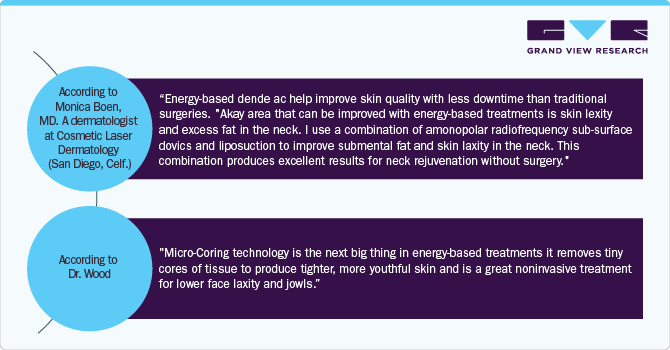
Key Energy-based Aesthetic Devices Companies:
The following are the leading companies in the energy-based aesthetic devices market. These companies collectively hold the largest market share and dictate industry trends.
- InMode
- Solta Medical
- BTL Aesthetics
- Sinclair
- Acclaro Medical
- Syneron Candela
- Lumenis
- El.en (Deka, Quanta, Asclepios )
- Cutera, Inc.
- Alma Lasers. (Sisram Medical Ltd.)
- Cynosure
- Lutronic Corporation
- Fotona
- Jeisys Medical Inc.
Recent Developments
-
In June 2024,Lumenis Be. Ltd. announced the launch of FoLix, a groundbreaking laser system for hair loss treatment. Recently approved by the FDA, FoLix is the first and only fractional laser system in the U.S. that offers a safe, effective, and natural solution for hair loss in both women & men.
-
In May 2024, Sinclair introduced its latest addition to the EBD, Sculpt & Shape. This new technology represents Sinclair’s commitment to advancing aesthetic treatments, offering innovative solutions for body contouring and facial rejuvenation.
-
In February 2024, Cynosure and Hahn & Company, which acquired Lutronic, entered into a definitive merger agreement to combine the two companies strategically. Both companies are leading global providers of energy-based medical aesthetic treatment systems and related technologies.
Energy-based Aesthetic Devices Market Report Scope
|
Report Attribute |
Details |
|
Market size value in 2024 |
USD 7.17 billion |
|
Revenue forecast in 2030 |
USD 15.93 billion |
|
Growth Rate |
CAGR of 14.2% from 2024 to 2030 |
|
Actual data |
2018 - 2023 |
|
Forecast period |
2024 - 2030 |
|
Quantitative units |
Revenue in USD million/billion and CAGR from 2024 to 2030 |
|
Report coverage |
Revenue forecast, company ranking, competitive landscape, growth factors, and trends |
|
Segments covered |
Product, application, end use, region |
|
Regional scope |
North America, Europe, Asia Pacific, Latin America, and MEA |
|
Country scope |
U.S.; Canada; Mexico; Germany; UK; France; Italy; Spain; Norway; Denmark; Sweden; Switzerland; Austria; Netherlands; India; Australia; Thailand; Singapore; Indonesia; Malaysia; Brazil; Argentina; Chile; Colombia; South Africa; Saudi Arabia; UAE; Kuwait; Qatar; Morocco; Jordan |
|
Key companies profiled |
InMode; Solta Medical; BTL Aesthetics; Sinclair; Acclaro Medical; Syneron Candela; Lumenis; El.en (Deka, Quanta, Asclepios ); Cutera, Inc.; Alma Lasers. (Sisram Medical Ltd.); Cynosure; Lutronic Corporation; Fotona ; Jeisys Medical Inc. |
|
Customization scope |
Free report customization (equivalent up to 8 analysts working days) with purchase. Addition or alteration to country, regional & segment scope. |
|
Pricing and purchase options |
Avail customized purchase options to meet your exact research needs. Explore purchase options |
Global Energy-based Aesthetic Devices Market Report Segmentation
This report forecasts revenue growth at global, regional & country levels and provides an analysis of the industry trends in each of the sub-segments from 2018 to 2030. For this study, Grand View Research has segmented the global energy-based aesthetic devices market report based on product, application, end use, and region:
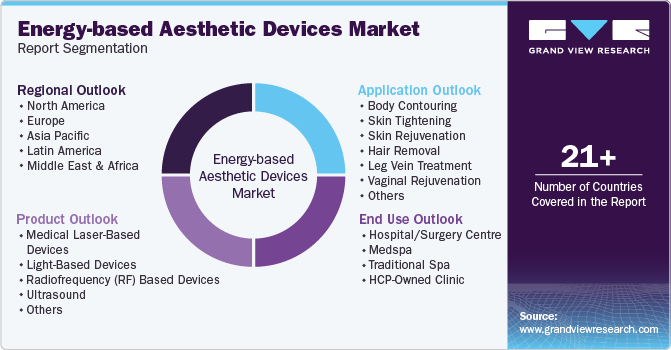
-
Product Outlook (Revenue, USD Million, 2018 - 2030)
-
Medical Laser-Based Devices
-
Light-Based Devices
-
Radiofrequency (RF) Based Devices
-
Ultrasound
-
Others
-
-
Application Outlook (Revenue, USD Million, 2018 - 2030)
-
Body Contouring
-
Skin Tightening
-
Skin Rejuvenation
-
Wrinkles
-
Acne & Other Scars
-
Skin Pigmentation
-
Aging
-
-
Hair Removal
-
Leg Vein Treatment
-
Vaginal Rejuvenation
-
Pigmented Lesion
-
Tattoo Removal
-
Others
-
-
End Use Outlook (Revenue, USD Million, 2018 - 2030)
-
Hospital/Surgery Centre
-
Medspa
-
Traditional Spa
-
HCP-Owned Clinic
-
-
Regional Outlook (Revenue, USD Million, 2018 - 2030)
-
North America
-
U.S.
-
Canada
-
Mexico
-
-
Europe
-
Germany
-
UK
-
France
-
Italy
-
Spain
-
Norway
-
Denmark
-
Sweden
-
Switzerland
-
Austria
-
Netherlands
-
-
Asia Pacific
-
India
-
Australia
-
Thailand
-
Singapore
-
Indonesia
-
Malaysia
-
-
Latin America
-
Brazil
-
Argentina
-
Chile
-
Colombia
-
-
Middle East & Africa
-
South Africa
-
Saudi Arabia
-
UAE
-
Kuwait
-
Qatar
-
Morocco
-
Jordan
-
-
Frequently Asked Questions About This Report
b. The global energy-based aesthetic devices market is expected to grow at a compound annual growth rate of 14.2% from 2024 to 2030 to reach USD 15.9 billion by 2030.
b. The global energy-based aesthetic devices market size was estimated at USD 6.36 billion in 2023 and is expected to reach USD 7.1 billion in 2024.
b. Some key players operating in the energy-based aesthetic devices market include Syneron Medical Ltd., Alma Lasers Inc., Zeltiq, El.En. Cutera, Merz Pharma GmbH & Co. KGaA, Lumenis Ltd., Sisram, Allergan Plc, and Cynosure.
b. Key factors that are driving the market growth include rise in public awareness towards medical aesthetics, increase in the number of obese population, technological advancements in energy-based aesthetic devices, and increase in the number of medspas and surgical centers across the globe.
b. North America dominated the energy-based aesthetic devices market with a share of 39.9% in 2023. This is attributable to the availability of skilled professionals, advanced techniques, and supportive government initiatives in the region.
We are committed towards customer satisfaction, and quality service.
"The quality of research they have done for us has been excellent."




